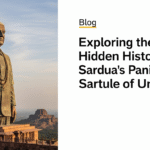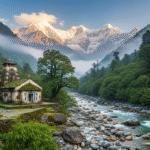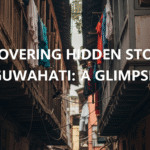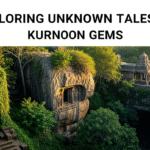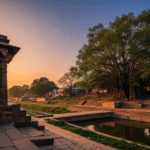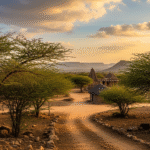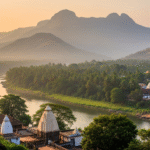Coorg sits beautifully in the Western Ghats. It’s high up, at 920 meters above sea level. Somwarpet town is your entry to Coorg’s hidden tales. Just a bit away, gems like Kote Betta and Beelur Golf Course wait quietly. They sit away from the busy tourist spots. These places hold Coorg’s untold stories, offering a glimpse into its heritage and the Kodava culture.
Waterfalls and wildlife are part of Coorg’s secret. But, it’s also known for its historical sites and culture. Coorg invites you to see more than just beautiful views. It shares stories of its past and the brave Kodava culture with every visitor.
Key Takeaways
- Somwarpet town, as the beginning point, elevates travelers to the heart of Coorg’s past and present allure.
- The formidable Kote Betta unearths Coorg’s unseen tales amongst its misty peaks and lush landscapes.
- Coorg heritage is not just in the landscape but also in the enduring culture and valiant sagas of the Kodava people.
- Ideal visiting periods for Coorg’s attractions highlight the region’s seasonal charisma and its impacts on Coorg tourism.
- The homestays neighboring Somwarpet, offering distinct perspectives of Coorg, blend local charm with immersive heritage experiences.
- Chiklihole Dam’s statistics reflect the infrastructure’s role in Coorg’s agricultural and ecological narrative.
Unveiling the Essence of Coorg’s Historical Tapestry
Coorg is wrapped in misty landscapes and lush coffee farms. It’s more than just scenery. It’s about the historic narratives of Coorg. This place in Karnataka is known for its rich culture and captivating stories. It holds secrets tied to its very essence.
Coorg secrets are not just in its beauty. They show in the daily life and traditions of local people. The Kodavas have their own culture and stories. They have kept some of the most fascinating stories. These stories are a big part of Coorg’s identity.
Coorg local legends often talk about bravery. These tales show a society closely connected to its land and values. They are not just old stories. They are lessons in bravery and respecting nature. They have been shared for generations. This preserves the ethos of this enchanting land.
Let’s look closer at how these legends and histories shape Coorg’s culture:
- Respect for Nature: Devara Kadu, or sacred groves, are carefully preserved. They show the community’s commitment to taking care of the environment.
- Architectural Marvels: Old forts and temples show Coorg’s architectural wisdom and beauty over centuries.
- Festivals and Traditions: Kodava festivals like Kailpodh are celebrated with music and dance. They reflect the martial history of this area.
One touching part of these historic narratives of Coorg is how they mix with nature. The green valleys of Coorg are as important as the people in these tales. This bond between the land and its stories makes the history come alive. It’s not just past events, but a living culture.
Exploring these stories, we gain not just knowledge of the past. We also understand the wisdom and views of the Kodava people. The history of Coorg, full of challenges and celebrations, guides the community. It reminds them of their everlasting link with their land.
Hidden Stories of Coorg
In the green valleys and foggy hills of Coorg, Coorg mysterious tales exist. They add depth to this area’s story. These tales attract those looking for secret paths. Besides coffee farms and pretty views, Coorg offbeat stories can be discovered. They show a strong bond between the land and its people. It feels like the wind itself shares stories.
People drawn to Coorg tourism find hidden treasures here. Old Kodava traditions come to life, showing the area’s true spirit. You might see special dances or sacred forests that keep secrets. Coorg’s culture gives a sneak peek into a world where myths meet reality.
Local legends about courage and nature’s magic are real here, guiding the Kodava folks. Heroes from stories and mysterious places are part of Coorg’s charm. These secrets are often softly spoken about in big estates.
These stories aren’t made for simple tourist books. Instead, they have been shared for ages, maybe by a fire or at town meets. This tradition, full of Coorg’s spirit, enchants those wanting to explore India’s mystical sides more.
So, people wanting to explore beyond regular tourist spots will find Coorg revealing its past. These ancient stories enrich every visitor’s experience, making it more meaningful.
Coorg’s Enigmatic Past Through Architecture and Ruins
Coorg’s landscape has many architectural wonders. The Madikeri Fort and Nalknad Palace are very special. They show Coorg’s history and cultural heritage.
Fortified Legacies: The Mystique of Madikeri Fort
The Madikeri Fort is in the center of Coorg. It’s not just old but tells of Coorg’s past. The fort started in the 17th century. It has seen many battles and changes. Its walls and design are important. They show Madikeri Fort history and its role in southern India’s military history.
Ruins Whispering History: The Nalknad Palace Lore
The Nalknad Palace is at Tadiandamol’s foot. It looks old but has beautiful carvings. The palace tells stories of royals and grand events. These stories are a big part of the Nalknad Palace secrets.
The Madikeri Fort and Nalknad Palace keep Coorg historic tales safe. They invite people to explore and find stories.
| Feature | Madikeri Fort | Nalknad Palace |
|---|---|---|
| Construction Era | 17th Century | 18th Century |
| Key Attributes | Strategic Location, Extensive Walls | Intricate Carvings, Royal Chambers |
| Main Appeal | Historical Importance | Royal and Political Lore |
| Current State | Well-preserved Museum | Ruins with Limited Access |
Visiting these places lets us see past architecture. It helps us understand the history that shaped the area. Both the fort and palace are important for learning about South Indian history.
Coorg’s Sacred Groves and the Tales They Harbor
Coorg isn’t just known for coffee. It’s also home to mystical Coorg sacred groves, or Devarakadus. These ancient forests are kept safe due to their spiritual and ecological value. They shelter many plants and animals, helping keep the area’s nature in balance. This shows how culture and nature work together.
Coorg folklore is rich with stories about these groves. Locals think they are homes to spirits and gods. Protecting these places is a sacred job for the community. They believe harming the groves might anger the gods. It’s a special mix of respect for nature and beliefs.
- Preservation of biodiversity
- Spiritual significance and communal worship
- Ancient rituals and traditional practices
These groves are more than just natural areas. They’re also cultural sites that teach us about ancient traditions. Each grove tells a story, often about the village it guards. They are important in local celebrations and traditions.
| Element of Coorg Sacred Groves | Ecological Impact | Cultural Significance |
|---|---|---|
| Biodiversity conservation | Home to rare species of flora and fauna | Sacred beliefs encourage conservation |
| Water preservation | Helps in maintaining local water cycles | Waters are often considered holy |
| Ancient trees and plants | Act as carbon sinks | Associated with deities and local legends |
So, Coorg’s sacred groves are a unique mix of beauty and spirituality. They are key for the environment and for keeping culture alive. The Coorg folklore linked to these groves deepens their cultural role, pulling us into a magical world.
The Saga of Coorgi Warriors and their Valor
Coorg in India’s Western Ghats tells a story. This story is about Coorgi warriors from the Kodava clan. They were known for bravery and great fight skills. This history is a big part of Coorg’s rich past.
Lasting Impressions of the Kodava Clan’s Resistance
The Kodava clan showed great bravery through time. They defended their home from invaders with courage. Their fight included alliances and cultural strength. This creates a legacy of defense and honesty in the region.
Song and Dance of Valor: Coorg’s Traditional Martial Tributes
Coorg’s martial traditions include special dances and stories. The ‘Kailpodh’ dance uses ancient weapons. The ‘Keilpoldu’ festival shares warrior tales. These traditions help keep the warrior spirit alive in Coorg’s culture. They link people to their brave ancestors.
Coorg’s Coffee Plantation Chronicles: A Bittersweet History
The Coorg coffee plantations history is tied to big changes in the area. At first, during British rule, these places became coffee farms. This transformed the local way of life and economy a lot.
Even though it was hard, it led to Coorg’s bittersweet tales of success in farming.
As the farms did well, Coorg’s coffee got famous worldwide. It began to be known in other countries. The hard work and culture changes show the tough part. But their success stories add a sweet side.
Coffee isn’t just about taste; it’s a story of survival, innovation, and prosperity, deeply embedded within Coorg’s lush landscapes.
This success story is also about modern ways to farm without harm. Sustainable agricultural practices became important. Stories like this show how old businesses can care for nature and still do well.

When telling Coorg’s bittersweet tales, you can’t overlook how people adapted. Turning forests into coffee farms changed life and work a lot. But, the community’s strong spirit led to success and wealth.
Stories from other places with good conservation, like Eaglenest Sanctuary in Arunachal Pradesh, add to our understanding. They show how Indian farming can be both old and new in caring for the land.
So, the Coorg coffee plantations history links big ideas like caring for the earth, changing cultures, and planning in business. It’s truly a story with both ups and downs.
The Forgotten Oral Traditions of Kodava Folklore
Coorg’s green hills are more than just pretty. They hold Kodava folklore, rich with stories and culture. These stories and songs have been shared for ages. They show what the Kodava people believe, value, and their history.
The Epic Recounts of Kodava Heroes in Folk Songs
Kodava folk songs bring heroes’ adventures to life. They share Kodava courage and values. These songs entertain and teach. They keep Coorg’s stories alive through melody. Heroes in the songs show Kodava bravery and spirit.
Love and Loss in Kodava Ballads: A Peek into Coorg’s Heart
Coorg’s songs also tell stories of love, sacrifice, and loss. These stories touch the Kodava people’s hearts. They show deep feelings and Kodava life. Listeners learn about Kodava values and identity through these songs.
These traditions are still celebrated today. They remember the past and enrich the present. Both locals and visitors can feel Coorg’s cultural legacy.
The Role of Rivers in Shaping Coorg’s Destinies
Coorg’s heart beats with its rivers. They are central to its culture, economy, and symbols. Coorg’s river lore is more than just water stories. It’s about life and the Kodava people’s heritage. The Cauvery River and its tributaries are vital. They help Coorg’s agriculture and shape its spirit.
The impact of rivers on Coorg is clear in the lush coffee farms. These farms need the rivers’ clean water. Rivers are part of Coorg’s rites and fests. They’re seen as life sources and spiritual hearts.

Rivers are to Coorg what the soul is to the body—a life force that shapes its character and destiny.
The rivers’ spiritual and economic effects are deep. They create trade paths. These paths connect Coorg to other places. This trade and cultural sharing make Coorg diverse.
Let’s compare activities around the major rivers:
| Activity | Cauvery River | Other Tributaries |
|---|---|---|
| Agriculture | Predominantly coffee and spice plantations | Rice paddies and other crops |
| Cultural Significance | Centre of major rituals and festivals | Local festivals and spiritual gatherings |
| Historical Impact | Trade and cultural exchange route | Localized trading routes |
| Economic Role | Significant contributor to local economy through tourism | Supports local economies on smaller scale |
Find out more about India’s vibrant areas here. Learn from river stories to deep heritage tales.
Truly, Coorg’s river lore tells us more. It shows Coorg as alive and ever-changing, shaped by water. The rivers are not just water; they’re lifelines defining Coorg and its people.
Conclusion
Our journey through the cultural heritage of Coorg has been eye-opening. This place is not just a collection of stories. It’s alive with a rich history and deep traditions. Coorg is surrounded by beautiful green landscapes.
The hidden stories of Coorg do more than show us the past. They invite us into a world where nature and culture mix perfectly. Coorg shows the diverse and rich culture of India. It’s a top place for those who love history and the beauty of now.
Coorg’s architecture, sacred groves, and martial dances add so much to our travels. Each part of Coorg makes the traveler’s journey richer.
Coorg’s coffee plantations and warriors’ stories make Coorg tourism even better. They draw in those who love history and nature. Close to Bangalore, Coorg offers lots of experiences. From eco-friendly places to stay to fancy villas.
You can choose where to stay. Maybe a local home or a tree house. Each offers comfort and a chance to really experience the culture. Coorg has something for everyone, whether you want peace, adventure, or both.
Traveling through Coorg’s history and nature is special. Each visit to Coorg lets you see more of its beauty and secrets. The efforts to keep Coorg’s culture alive are shaping its future.
This balance of old and new makes Coorg a wonderful place to visit. It keeps drawing travelers back. Anyone who loves to explore India’s rich culture will love Coorg.
FAQ
What are some of the hidden stories of Coorg?
Coorg, also known as Kodagu, has many untold stories. You will find legends, mysterious events, and stories about sacred groves and ancient ruins. These include tales of brave Coorgi warriors and the story of coffee’s impact on the area.
How does Coorg’s architecture reflect its rich history?
Coorg’s history shines in its buildings. The Madikeri Fort shows Coorg’s importance. The Nalknad Palace ruins tell of royal life and drama. They help us feel connected to Coorg’s vast past.
Can you tell me more about the Kodava Clan and their martial traditions?
The Kodava Clan is known for its strong military past. Coorg honors this with traditional songs and dances. A dance called ‘Kailpodh’ is performed with native weapons. This shows the enduring spirit of Coorg’s people.
Are there any specific festivals in Coorg that celebrate its warriors?
Yes, Coorg has the ‘Keilpoldu’ festival. It celebrates the bravery of its warriors. Stories of heroism are told, and traditional martial arts are performed. It keeps the Kodavas’ warrior spirit alive for the future.
What role do coffee plantations play in the history of Coorg?
Coffee plantations have been vital in Coorg’s growth. They started during British rule and changed Coorg’s economy and landscape. Coorg’s coffee is now loved globally. It’s a success story of resilience.
How is folklore preserved in Coorg?
Coorg’s folklore lives on through oral traditions. Folk songs and ballads share cultural values and historical stories. These tales are a core part of Coorg’s heritage and vibrant culture.
Do rivers play a significant part in the history of Coorg?
Yes, rivers, especially the sacred Cauvery, are key to Coorg. They support farming, trade, and have spiritual significance. Stories of river deities and rituals show the deep bond between the Kodava people and their rivers.
What makes Coorg a unique destination for tourists interested in heritage?
Coorg lets tourists see a different side of India’s heritage. It has secret stories, ancient forts, and spiritual tales. Coorg mixes nature, history, and culture in a way that’s rare to find.

